 |
|
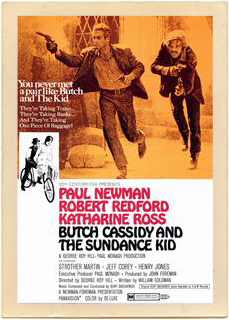 Butch Cassidy and the Sundance Kid Butch Cassidy and the Sundance Kid1969. 20th Century Fox, 20th Century Fox Home Entertainment, Color, Aspect Ratio 2.35 : 1, 110 minutes, Not Rated Release Date: October 24, 1969 Butch Cassidy and the Sundance Kid is available at Amazon.com as a Wide Screen Special Edition DVD, a 2-Disc Collector’s Edition DVD, on Blu-Ray, and on VHS. Movie Synopsis: The ultimate telling of the story of Butch Cassidy, the Sundance Kid, and The Hole in the Wall Gang; complete with sepia-tone film and stills, horseriding scenes accompanied by a classical-pop chorus, and plenty of eye-popping action from start to finish. Cast: Paul Newman, Robert Redford, Katharine Ross, Strother Martin, Henry Jones, Jeff Corey, Cloris Leachman, Kenneth Mars Director: George Roy Hill Thoughts on the Movie: I hate to use the word awesome to describe anything, because it has been overused to the point of being meaningless. But... Butch Cassidy and the Sundance Kid is a truly awesome film. Amazingly innovative for its time, and even by today’s standards, there is an incredible mix of ideas, both aural and visual, that simply takes this movie way over the top. So many wonderful tricks are played on the viewer, and cinematic styles jump from one to another almost seamlessly. Then you have the cast: Paul Newman, Robert Redford and Katharine Ross. In a word: wonderful. You just love them. And really, could you put three more attractive people together in a movie? (I’m sure it’s been done, but nothing’s coming to mind at the moment). In their first “buddy paring,” Newman and Redford hit it out of the ballpark. Butch and Sundance are the quintessential cowboys. And we are with them to the very end. Entertainment at its finest! ~Jean 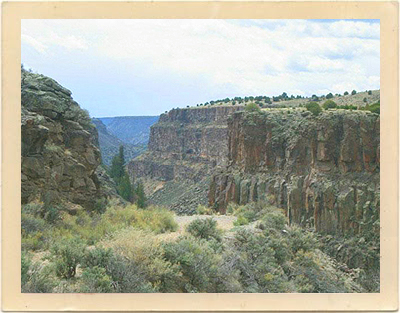 Location Site: Location Site:Upper Rio Grande Gorge, near Taos, New Mexico (see Map) Some of the most beautiful open country scenes in Butch Cassidy and the Sundance Kid were shot in Northern New Mexico in the Upper Rio Grande Gorge area. The Upper Rio Grande Gorge (36° 18’ N, 105° 46’ W) starts at the Colorado border, extends along the river to below Taos, New Mexico, and includes approximately 25 miles of the Rio Grande Wild and Scenic River. Its dominant features are the 200 to 2,600 foot width and 300 to 800 foot deep gorges, carved into the basalt lava flows. Landforms in the complex also include the forested higher elevations and vast shrub and grass-covered, rolling mesas. Elevations range from 7,000 feet on the mesa scrublands to 9,500 feet high above. Pinon and juniper woodlands cover the higher areas. On the high mesa are also numerous natural depressions with no natural outlets, thus feeding the aquifers of the Rio Grande Watershed. These are crucial water sources in an otherwise arid environment. Right: The beautifully scenic area known as the Upper Rio Grande Gorge, just north of Taos, New Mexico, was used for a number of key scenes in “Butch Cassidy and the Sundance Kid.” The area provides a diversity of habitats from riparian to the forests of the high mesas. Riparian vegetation lining the rivers include cottonwood, willow, boxelder, snowberry, mountain mahogany, golden currant, and gooseberry; as well as a variety of grasses. The canyon walls and high uplands contain conifer woodlands, blue spruce, white fir, ponderosa and pinon pine, along with juniper and Douglas fir. Wildlife in these areas include: chipmunks, squirrels, beavers, porcupines, mule deers, elk, gray foxes, coyotes, badgers, bears, bobcats, and mountain lions. The gorge also supports a great diversity of passerine birds, including the Southwestern Willow Flycatcher, while canyon walls provide habitat for hawks and eagles. Archaeological sites indicate that human occupation of the area dates back 7,000 years. About Taos, New Mexico: Taos, New Mexico (population 4,700, elevation 6,969 feet; 36° 23’ 38” N, 105° 34’ 36” W) is located in northern New Mexico, approximately 60 miles north of Santa Fe, on US 84. Taos calls itself the “Town of Taos” and was incorporated as such in 1934. Taos is an enchanted town of romantic courtyards, cottonwood trees, narrow streets, and adobe walls. It is also a world-famous art and literary center (Taos boasts more artists per capita than Paris: approximately 1,336, with 96 galleries!). Taos is also a very popular ski resort in the winter and is adjacent to the historic Taos Pueblo. To learn a lot more about Taos, see our Taos Information page. 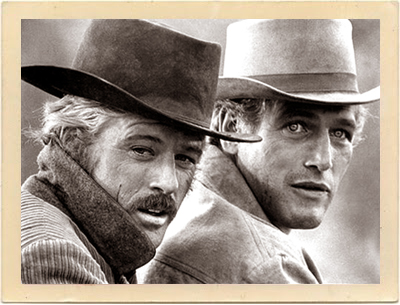 Lodging & Dining: Lodging & Dining:For Recommended Hotels, Motels and Lodges in Taos, see: Taos Lodging For Recommendations for Dining in Taos, see: Taos Food Filming Info: All the Bolivia scenes were filmed in Mexico, where almost the entire cast and crew, and the director, came down with Montezuma’s Revenge. Only Robert Redford, Paul Newman and Katharine Ross were spared, because they refused to drink the water catered on the set, and stuck to drinking soda and alcohol for the duration of the shoot. Right: Robert Redford and Paul Newman star in the classic 1969 Western, “Butch Cassidy and the Sundance Kid.” The river jump was shot at the studio’s Century Ranch near Malibu, California. The stars’ stuntmen actually jumped off of a construction crane by Century Lake. The crane was obscured by a matte painting of the cliffs. Newman and Redford start the jump in Colorado, but only land on a mattress. Other locations used in Butch Cassidy and the Sundance Kid include: Grafton, St. George, Springdale, and Snow Canyon, Utah; Silverton, Telluride, and Durango, Colorado; Taxco and Cuernavaca, Mexico; Stage 16 on the 20th Century Fox studio lot, and 20th Century Fox Ranch at Malibu Creek State Park. Awards: 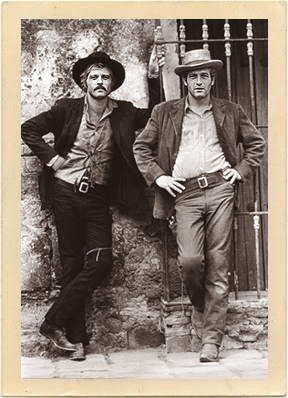 • Butch Cassidy and the Sundance Kid won an Oscar for Best Cinematography. • Butch Cassidy and the Sundance Kid won an Oscar for Best Cinematography.• Butch Cassidy and the Sundance Kid won the BAFTA Award for Best Film. • Butch Cassidy and the Sundance Kid won the Golden Laurel Award for Best Action Drama. • Butch Cassidy and the Sundance Kid was nominated for an Oscar for Best Picture. • Butch Cassidy and the Sundance Kid was nominated for a Golden Globe for Best Motion Picture–Drama. • George Roy Hill won the BAFTA Award for Best Director. • George Roy Hill was nominated for the Directors Guild of America Award for Outstanding Directorial Achievement in Motion Pictures. • George Roy Hill was nominated for an Oscar for Best Direction. • Robert Redford won the BAFTA Award for Best Actor. Right: Robert Redford and Paul Newman take a moment to pose in character as they both take a star turn in the classic film, “Butch Cassidy and the Sundance Kid.” • Katharine Ross won the BAFTA Award for Best Actress. • Paul Newman was nominated for the BAFTA Award for Best Actor. • Burt Bacharach won an Oscar for Best Music, Original Score for a Motion Picture. • Burt Bacharach and Hal David won an Oscar for Best Music, Original Song. • Burt Bacharach won a Golden Globe for Best Original Score. • Burt Bacharach won a Grammy Award for Best Original Score Written for a Motion Picture or Television Show. • Burt Bacharach and Hal David were nominatef for a Golden Globe for Best Original Song. • William Goldman won an Oscar for Best Writing, Story and Screenplay Based on Material Not Previously Published or Produced. • William Goldman won the BAFTA Award for Best Screenplay. • William Goldman won the Writers Guild of America Award for Best Drama Written Directly for the Screen. • William Goldman was nominated for a Golden Globe for Best Screenplay. 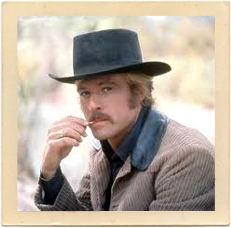 Movie Trivia: Movie Trivia:• Dustin Hoffman was considered for the role of Butch Cassidy. • The actual name of Butch and Sundance’s gang was “The Wild Bunch.” However, when the Sam Peckinpah film, The Wild Bunch (1969), was released a few months earlier, the name of the gang was changed to “The Hole in the Wall Gang” to avoid confusion with Peckinpah’s film. Right: Robert Redford as the Sundance Kid. • According to screenwriter William Goldman, his screenplay originally was entitled “The Sundance Kid and Butch Cassidy.” Both Steve McQueen and Paul Newman read the script at approximately the same time, and agreed to do it, with McQueen playing the Sundance Kid. When McQueen dropped out, the names reversed in the title, as Newman was such a superstar. • Paul Newman did his own bicycle stunts, after his stunt man was unable to stay on the bike. The only bicycle scene not done by Newman was the scene where Butch crashes backwards into the fence. Oddly enough, that was done by cinematographer Conrad L. Hall. • Butch Cassidy and the Sundance Kid was filmed roughly the same time as Hello, Dolly! (1969), on the sound stage next door. Director George Roy Hill believed that the studio would allow him to film the New York scenes on “Dolly’s” sets, since the two film’s daily shooting schedules were totally different. But after production started, the studio informed him that it wanted to keep the sets for “Dolly” a secret, and so refused him permission. To work around this, Hill had Robert Redford, Paul Newman and Katharine Ross pose on the sets and photos were taken. He then inserted images of the three stars into a series of 300 actual period photos, and spliced the two different sets (real and posed) together to form the New York montage. • The climactic gun battle at the end of the movie was historically inaccurate. There were only a few uniformed police officers/officials present during the shootout in southern Bolivia, where Cassidy and Sundance were supposedly killed. There were only three Bolivian soldiers who actually took part in the fight alongside the local police, not the hundreds shown in the film. In addition, the casualty count among the Bolivian policemen was nowhere near as enormous as shown and most of the gun battle took place in the evening and at night, not in broad daylight as in the movie. These were the main reasons why the Bolivian government at first banned the film from being shown in that country. 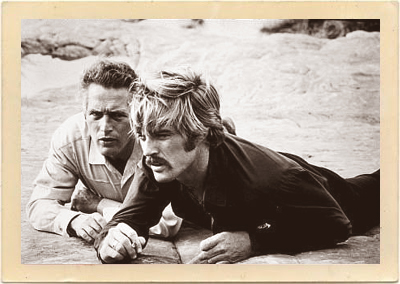 • The sister of the real Butch Cassidy often visited the set, and her presence was welcome to the cast and crew. During lulls in shooting she would tell stories about her famous brother’s escapades, and was amazed at how accurately the script and Paul Newman portrayed him. • The sister of the real Butch Cassidy often visited the set, and her presence was welcome to the cast and crew. During lulls in shooting she would tell stories about her famous brother’s escapades, and was amazed at how accurately the script and Paul Newman portrayed him.Right: Butch (Paul Newman) and Sundance (Robert Redford) are on the watch for the super-posse who avidly pursues them in “Butch Cassidy and the Sundance Kid.” • The locomotives that pull the trains are completely wrong for the time and place in which the movie is set. They are class K-28s, which have a very distinct and recognizable appearance. They were not produced until 1923, and were used exclusively by the Denver and Rio Grande Western Railroad on their narrow gauge track in Colorado and New Mexico. (This is now the Cumbres and Toltec Scenic Railroad.) • The opening 20th Century-Fox logo is shown in sepia tone instead of its usual full color. • Contrary to popular belief, the vocalists on the Burt Bacharach-penned song, South American Getaway, were not The Swingle Singers. It was instead performed by the Ron Hicklin Singers, a group of Los Angeles studio vocalists, best known as the real singers behind the background vocals on The Partridge Family recordings. • Two fictional western characters may have been derived from the name Butch Cassidy: Butch Cavendish, the arch rival of The Lone Ranger, and good guy Hopalong Cassidy, whose popularity exceeded many western heroes in the 1940s and 1950s. Character Quote: “Who are those guys?” ~Butch Cassidy (Paul Newman) |
|